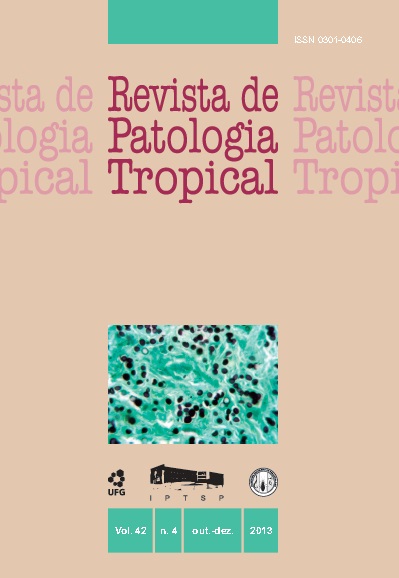CLINICAL AND EPIDEMIOLOGICAL CHARACTERIZATION OF Trypanosoma cruzi INFECTED PATIENTS ATTENDING A REFERRAL CENTER OF CHAGAS DISEASE IN PARAGUAY, PRELIMINARY RESULTS
DOI:
https://doi.org/10.5216/rpt.v42i4.27929Palavras-chave:
Characterization, clinical, epidemiological, Trypanosoma cruzi, referral center, Chagas diseaseResumo
Although vector transmission of American trypanosomiasis has been interrupted and there are decreased rates of new infections in large areas of Latin America, there are still many chronically infected patients. We determined the clinical and epidemiological characteristics of Trypanosoma cruzi infected patients attending the Department of Tropical Medicine of the Institute of Research in Health Sciences (IICS) from 1985 to 2007 by analyzing their clinical records, maintaining anonymityand confidentiality. The SPSS 11.5 statistical package was used to analyze 1024 patient records of whom 70.1% (723/1024) were in the age group of 21-60 years (38.7±10.5); 74.5% (763/1024) were born in endemic departments, 13.2% (135/1024) in the Central department, 5.9% (60/1024) in Asunción and 6.4% (66/1024) in other departments. At consultation, 38.2% (391/1024) lived in endemic departments, 27.8% (285/1024) in Central Department, 22.6% (231/1024) in Asunción and 11.4% (117/1024) in others. Consultation reasons were: beatings (43.5%; 445/1024), effort dyspnea (34.1%; 349/1024), enervation (32.8%; 336/1024), headache (26.1%; 267/1024) and constipation (24.7%; 253/1024), among others. Half (512/1024) said they were not bitten by kissing bugs, 26.2% (268/1024) did not know or remember, 23.8% (244/1024) were bitten and 37.6% (385/1024) had kissing bugs in their houses. About 10% (104/1024) received blood transfusion and 89.8% (920/1024) did not; 24.8% (254/1024) donated blood while 75.2% (770/1024) did not. Clinically, 73.2% (750/1024) were indeterminate patients, 16.2% (166/1024) had cardiopathy, 5.1% (52/1024) megacolon and 1.5% (15/1024) megaesophagus. Most patients were in the age group of highest economic productivity and although the majority had been born in endemic rural regions most of them were living in urban areas, likely reflecting work migration. Clinically, most patients were indeterminate and cardiac lesions predominated over digestive lesions. This is a classical chagasic population and control programs should continue developing public health policies considering the characteristics of the affected populations to offer appropriate diagnosis and treatment.
Downloads
Downloads
Como Citar
Edição
Seção
Licença
The manuscript submission must be accompanied by a letter signed by all authors stating their full name and email address, confirming that the manuscript or part of it has not been published or is under consideration for publication elsewhere, and agreeing to transfer copyright in all media and formats for Journal of Tropical Pathology.

